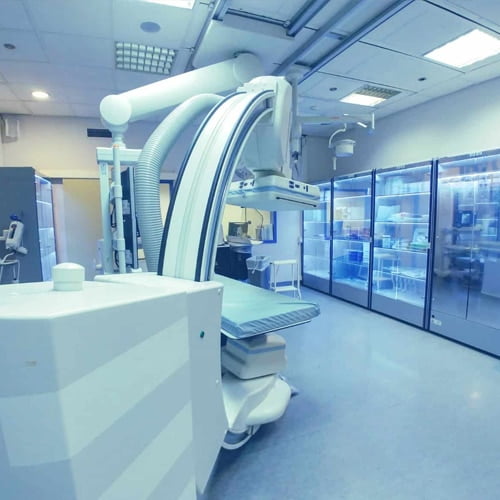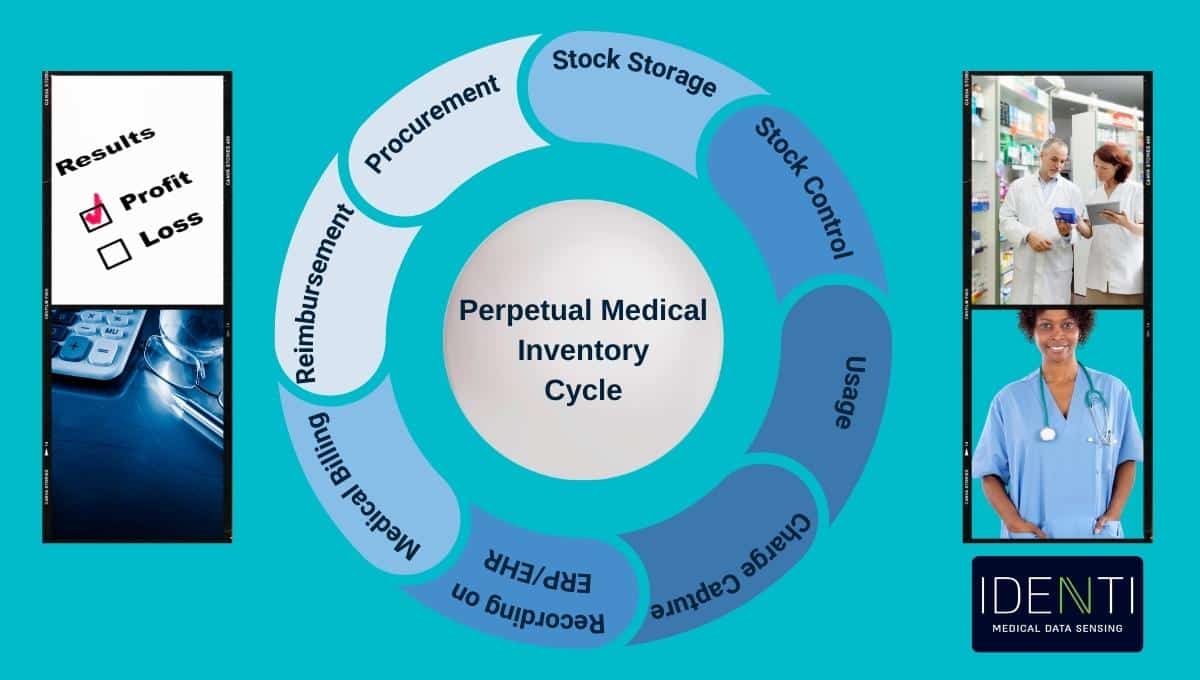Hospital inventory management plays a critical role in patient safety, operational efficiency, and financial performance.
Without accurate visibility into supplies, implants, and medications, hospitals face stock-outs, waste, expired inventory, and revenue loss.
As costs rise and staffing pressures increase, effective inventory management has become essential to ensuring availability, compliance, and control across clinical environments.
Discover the key aspects of hospital inventory management and find out how healthcare organizations can find solutions that not only solve many day-to-day challenges but also drive organizational success.
Medical inventory in hospitals involves the management of stock items used in patient care. This covers both high-use/low-value items such as swabs and syringes, as well as expensive implants and surgical kits. These higher-value consumables make up a sizeable chunk of the hospital’s budget, so the tracking, management, and accounting of this medical inventory are crucial for sound financial management.
This article will look at the importance of accurate inventory management that results in a perpetual inventory.
IDENTI Medical has a suite of automated hospital inventory management solutions including:
- TotalSense – an RFID smart cabinet powered by AI software – for end-to end implant tracking and automated inventory management
- Kanban and PAR automation – simple tools to transform manual two-bin Kanban, as well as PAR-level medical supplies management, into an accurate and automated system that connects to AI software.
- Narcotics Cabinet – secure, automated management of controlled drugs and narcotics – especially designed for the clinical setting for decentralized dispensing
- Snap&Go – point of use data capture that achieves digital charting of all items with ease, including non-stock items.
Let’s look at why our automated tools are so important.
INNOVATIVE MEDICAL SENSING SOLUTIONS
In a regular organization, inventory management matters, but in a hospital, the stakes are that much higher as incomplete or unchecked inventory can put lives at risk.
Hospital inventory management processes need to capture the journey that the inventory makes from delivery through to usage – but that’s not the end destination – data relating to usage then needs to be processed internally so that the inventory circle can be closed.
Hospital inventory management follows a cycle that covers many different stages:
To cover the full medical inventory cycle and also adhere to FDA and other regulations, end-to-end hospital inventory workflows are needed. In particular, the OR workflow needs to be kept quick and simple so that it does not become an admin burden during a time when the medical team and patient need the nurse’s attention. In addition, any new IT installed needs to integrate with existing hospital systems, such as ERP and EHR.
Why hospital inventory management matters
Due to the critical nature of patient healthcare, medical inventory needs to be available upon demand. This requires the hospital to have accurate knowledge of current stock levels, right down to the location of specific items. Gaining such a detailed overview of the hospital’s inventory is not as simple as it sounds. In addition, it’s not just the stock items themselves that need to be visible but all of its associated data too.
Setting up effective inventory management may not be simple but it is vital to get this aspect of hospital administration right.
Managing inventory is:
- a critical process that underpins the delivery of quality patient care
- one of the largest budget areas for the hospital
- a major contributor to the organization’s commercial success
Although hospital inventory management systems need to be robust, they also have to be flexible, as the fallout from disrupted supply chains during COVID has taught us.
With such a lot at stake, inventory management merits high-level priority, however, it’s a complex and cross-organizational issue. Inventory may have the operating room at its core but as the diagram below shows, there are key periphery functions involved in ensuring that medical supplies are available upon demand. A holistic approach is therefore needed so that the system works across the medical inventory supply chain.
Medical Inventory Procurement and Tracking
Inventory management in hospitals, simply put, just means that hospitals need to ensure they carry adequate stock to meet patients’ needs however, in practice the unpredictable nature of operating rooms means that it is impossible to anticipate every need. Hospitals never know who is going to walk through their doors and what medical needs they will have. Even for planned surgeries, decision-making happens in real-time meaning that specific or additional inventory requests can be made on the spot. Some of these requests may require a transfer from outside of the department or delivery directly from suppliers – and these items are particularly susceptible to remaining untracked in the hospital inventory management system.
Stock is mobile, it doesn’t stand still, so a system is required that:
- provides a tracking and audit trail of all inventory stock
- enables OR staff to electronically capture the data of all items used during procedures
Without quick, simple, and effective workflows in place, inventory tracking cannot be comprehensively carried out in an OR setting.
Circulatory Nurses have limited time to spend on capturing item data during surgery and as you will see in the alarming statistics below, in too many cases they struggle with this task.
Only when successful item capture and tracking are achieved, can the data be shared with the medical records, medical billing, procurement teams, and vendors. Non-captured items have a bottom-line impact and hamper inventory management. Capturing chargeable items used in surgery is, therefore, a critical workflow.
Check out some surprising facts about hospital inventory management:
With high rates of chargeable items going uncaptured and with nurses struggling with hospital inventory management tasks – the statistics above clearly show that hospitals have specific inventory management problems in OR.
Interested in More Information?
Hospital Inventory Management Challenges
There is a multitude of challenges faced by hospitals that can lead to medical inventory mismanagement and here are just a few:
- Keeping the inventory Item List accurate – with constant vendor updates and changes this is a complex task, particularly when you consider that there are often thousands of products provided by hundreds of suppliers. If your central control list is not up to date then the wrong data appears on hospital systems. Then there is the knock-on effect of bad data being used for medical claims, resulting in low reimbursement rates, payment denial, etc.
- Managing expiry dates and recalls – Stock rotation is not simple in the complex hospital setting so it is difficult to ensure that staff selects the soonest to expire items. Not spotting an expired or recalled item before usage in surgery can jeopardize patient safety and lead to costly litigation. Time-pressed nurses are the last line of defense but human errors can happen when working in a critical and chaotic OR room. Even if expired items are spotted in time, the wasted stock is a real inventory issue and racks up considerable and unnecessary financial loss.
- Having Adequate Inventory Levels – Without transparent stock control, hospitals have inaccurate data on inventory levels and procurement becomes a guessing game. In addition, organizations are not able to determine the minimum and maximum stock levels they need. This puts the organization at risk of:
- Stockouts – Inadequate medical supply levels in a hospital cause delays, canceled operations and compromise patient safety. Some nurses admit that they have ‘stock insecurity’ and can hoard certain items. In addition, in a bid to ensure adequate stock levels and prevent the potentially disastrous fallout from stockouts, hospitals tend to err on the side of caution and over-order medical supplies.
- Overstocks – Overstocking may ensure continual supply but it’s an unnecessary investment in a stock that is not needed, leads to expiry issues, and wastes valuable dollars and storage space.
- Without clarity on real stock levels and accurate usage data, hospitals cannot carry out demand-driven procurement, identify trends or predict future needs.
- Unforeseen circumstances – COVID 19 has shown us that unexpected events in the world can have a dramatic effect on the supply chain. Lessons need to be learned and supply chain contingency plans put in place so that hospitals can minimize the effect of global or local events. If regular supply routes are not possible the inventory management system needs to be versatile enough to cope with alternative stock items or inventory from new suppliers not on their current Item List.
- Uncaptured charges – Failure to scan all inventory items used during a procedure – including any delivered direct to the OR and therefore not on the hospital’s inventory list – risk being missed off medical billing and reimbursement. Hospitals are care providers but they are businesses too and omissions affect the bottom line.
- Compliance – There are regulatory and compliance requirements that hospitals need to meet, for example, the FDA’s UDI regulations. Hospitals need to ensure that complete UDI data is captured including manufacturer, lot number, serial number, expiration date, and manufacturer’s SKU. Capturing this data is not always straightforward. Many hospitals still rely on manual entry which is prone to human error, others have barcode scanning but this method has its issues. Many medical inventory items contain multiple barcodes on the packaging, which causes delays and confusion. Even when the correct barcode is scanned it may only contain partial information. Nurses are then required to spend time looking for the missing data to correctly log all items.
- Lost or missing inventory – It happens in all hospitals – some inventory goes missing. It could have been:
- transferred to another department without being recorded on the system
- removed but not used
- misplaced
- stolen
Missing items mean that the inventory system and the actual inventory do not tally. As far as the system is concerned the stock item is in storage but in reality, it is not. This mismatch gives the hospital administrators a distorted picture of actual stock and causes procurement errors. In some cases, the nursing team may have some recollection of where a particular item may have gone, and it is possible that, with some effort, it can even be tracked down. However, this takes precious time away from busy nurses. The confusion over actual stock levels also becomes a flashpoint with vendors as disputes arise around item usage and payment.
- Uninformed management – Managers require accurate data to give them visibility of inventory movement as well as to drill down further to determine:
- which stock was used?
- when was it used?
- who handled the stock?
- which patient was it used on?
- what was the related medical procedure?
- which doctor oversaw the surgery?
- and so on …
- Admin burden on nursing staff – The nursing staff is responsible for providing all medical inventory to the surgical team at the point of use. They have conflicting demands on their time and the admin burden of trying to find the right barcode to swipe or searching for unlisted data causes stress and detracts from patient care. It also has a direct effect on job satisfaction and morale, which can even affect staff retention.
Without this key data, budget and cost planning exercises are just ‘best guess’. Lack of data means it is impossible to identify areas of loss, waste, and under or over-ordering. Without accurate data, managers are hindered in their efforts to tame costs or reduce losses. Poor inventory systems hamper the controlled management of hospital stock and add unnecessary expense to the bottom line.
These points represent just some of the hospital inventory challenges that providers are trying to manage. Finding a way to overcome these challenges is a pressing priority not just to improve the smooth running of the hospital and provide optimum patient care but also, as you will see below, the related losses are staggering.

The Benefits of using medical inventory management software
Commonly used point of use inventory management techniques such as manual inputting and barcode scanning are not robust enough to solve the full range of problems.
The introduction of an effective healthcare inventory management system can address hospital inventory issues. With a comprehensive system in place, healthcare organizations can solve their problems and address their challenges.
Care should be taken when selecting inventory management software as not all offer end-to-end solutions or can remain relevant as the healthcare sector goes through continuous change.
Key features to look out for are:
- Ease of use
- Automated Item Master maintenance in a central, global database removing the need to undertake this task locally
- Workflow optimization
- Quick and easy as well as comprehensive data capture
- Interoperability with hospital software
- Full integration with all hospital IT systems including ERP and
- Facilitates full compliance and charge capture
- 100% inventory tracking and charge capture
- Optimum medical billing and reimbursement
- Lowers risk for the hospital and patient
- Removal ‘Never Events’ due to point of use flagging of expired and recalled products
- Reduced admin time by clinical staff – putting the patient back in the spotlight
- Improves the bottom line
- Significantly reduced loss, wastage, and costs
- Significantly increased savings (we’re talking many millions of dollars a year!)
- Data-driven forecasting – the accurate cost of care planning and budget setting
- Optimized inventory levels based on actual need – determined from real costs, stock volumes, and usage
- Improved supplier relationships
Conclusion
Preventing inventory pitfalls removes time, cost, and staffing pressures so that hospitals can work in a proactive manner to provide optimum healthcare and run financially sound businesses.
Effective hospital inventory management is not an aspiration, it is achievable. In order to have a medical inventory supply chain that works for all parties and copes with the complex and unpredictable healthcare setting, the ideal solution is a bespoke inventory management system for hospitals. Healthcare inventory management needs a product that can meet its complex requirements, including high numbers of individual suppliers, high volume and a vast range of inventory items, and last-minute, urgent demands. Robust inventory software can work effectively in a hospital setting.
Modern hospitals are run with a range of IT systems and any new technology needs to be fit for purpose and integrate within the technical framework of the hospital.
There is a broad range of challenges, but the critical point is ensuring accurate inventory tracking, particularly at the point of use. This is currently the weakest point of the chain where most ‘inventory leakage’ happens.
As busy, time-challenged nurses are the key players in item capture, any new system needs to minimize the admin time spent undertaking this task, giving them maximum time to support the patient and clinical team.
Once the inventory is accurately tracked and the data becomes clean, smarter business decisions can be made based on actual reality. The hospital can use these data insights to better understand their needs and regain control of the inventory management process from beginning to end.
It sounds perfect.
It sounds like an inventory utopia.
But this is a far cry from where many hospitals are right now.
Luckily a ‘perfect fit’ solution is actually already available and is being used in many hospitals.
Find out more about hospital inventory management technology, including pioneering point-of-use charge capture solutions powered by AI vision.
hospital inventory management hospital inventory management hospital inventory management hospital inventory management hospital inventory management hospital inventory management hospital inventory management
















